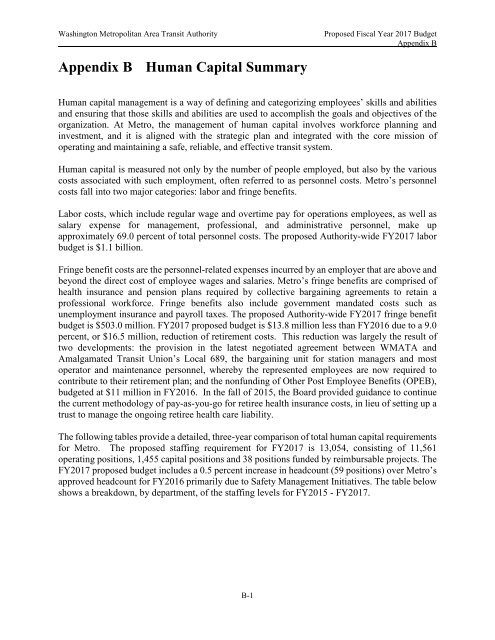FY2017 PROPOSED BUDGET
FY2017%20Proposed%20Budget
FY2017%20Proposed%20Budget
You also want an ePaper? Increase the reach of your titles
YUMPU automatically turns print PDFs into web optimized ePapers that Google loves.
Washington Metropolitan Area Transit Authority<br />
Proposed Fiscal Year 2017 Budget<br />
Appendix B<br />
Appendix B Human Capital Summary<br />
Human capital management is a way of defining and categorizing employees’ skills and abilities<br />
and ensuring that those skills and abilities are used to accomplish the goals and objectives of the<br />
organization. At Metro, the management of human capital involves workforce planning and<br />
investment, and it is aligned with the strategic plan and integrated with the core mission of<br />
operating and maintaining a safe, reliable, and effective transit system.<br />
Human capital is measured not only by the number of people employed, but also by the various<br />
costs associated with such employment, often referred to as personnel costs. Metro’s personnel<br />
costs fall into two major categories: labor and fringe benefits.<br />
Labor costs, which include regular wage and overtime pay for operations employees, as well as<br />
salary expense for management, professional, and administrative personnel, make up<br />
approximately 69.0 percent of total personnel costs. The proposed Authority-wide <strong>FY2017</strong> labor<br />
budget is $1.1 billion.<br />
Fringe benefit costs are the personnel-related expenses incurred by an employer that are above and<br />
beyond the direct cost of employee wages and salaries. Metro’s fringe benefits are comprised of<br />
health insurance and pension plans required by collective bargaining agreements to retain a<br />
professional workforce. Fringe benefits also include government mandated costs such as<br />
unemployment insurance and payroll taxes. The proposed Authority-wide <strong>FY2017</strong> fringe benefit<br />
budget is $503.0 million. <strong>FY2017</strong> proposed budget is $13.8 million less than FY2016 due to a 9.0<br />
percent, or $16.5 million, reduction of retirement costs. This reduction was largely the result of<br />
two developments: the provision in the latest negotiated agreement between WMATA and<br />
Amalgamated Transit Union’s Local 689, the bargaining unit for station managers and most<br />
operator and maintenance personnel, whereby the represented employees are now required to<br />
contribute to their retirement plan; and the nonfunding of Other Post Employee Benefits (OPEB),<br />
budgeted at $11 million in FY2016. In the fall of 2015, the Board provided guidance to continue<br />
the current methodology of pay-as-you-go for retiree health insurance costs, in lieu of setting up a<br />
trust to manage the ongoing retiree health care liability.<br />
The following tables provide a detailed, three-year comparison of total human capital requirements<br />
for Metro. The proposed staffing requirement for <strong>FY2017</strong> is 13,054, consisting of 11,561<br />
operating positions, 1,455 capital positions and 38 positions funded by reimbursable projects. The<br />
<strong>FY2017</strong> proposed budget includes a 0.5 percent increase in headcount (59 positions) over Metro’s<br />
approved headcount for FY2016 primarily due to Safety Management Initiatives. The table below<br />
shows a breakdown, by department, of the staffing levels for FY2015 - <strong>FY2017</strong>.<br />
B-1


